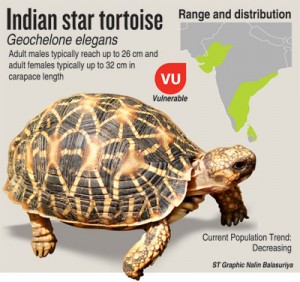
Tortoise catch sheds light on another front in criminal wildlife trade
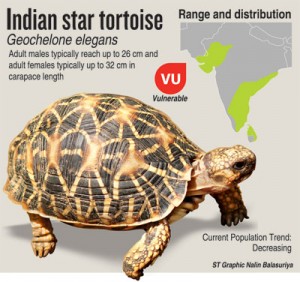
Detection of a massive number of star tortoises on a fishing boat off Kalpitiya has raised fears that smugglers are plundering Sri Lanka’s reptiles from the wild for the illegal trade.
Recently, two suspects were held with 2,089 star tortoises from India in a fishing boat intercepted by the navy last Sunday at five nautical miles off Kalpitiya during a patrol. Twenty one of the star tortoises are now dead and the rest are in the care of a facility under the Zoological Gardens.
The navy spokesman Lieutenant Commander Chaminda Walakuluge said:
“This was the first time we detected tortoise smuggling at sea
The suspects were handed over to the customs and later remanded after being produced in court. Initial inquiries have shown that the tortoises were to be sold at US$50 each (Rs 7,664), after being smuggled out of Sri Lanka.
Customs sources suspect the star tortoises are to be re-exported. The customs media spokesman Dharmasena Kahandawa said the suspects will be questioned.
The former customs deputy director, Samantha Gunasekara, told the Sunday Times that foreign and local tortoises are traded illegally to Thailand, Indonesia and Singapore.
Sometimes, these reptiles are brought to Sri Lanka from Chennai to be traded to Singapore from where they reach Europe, including Germany.
Mr Gunasekara who was also the founder of the customs Bio Diversity Protection Unit, said the origin of the star tortoises needs to be established because if they are released into the wilds they can destroy the existing tortoise populations of Sri Lanka.
Director General of the Zoological Department, Ms Dammika Malsinghe, said tests will be done. Six of the 2,089 star tortoises were dead at first and by Friday morning 21 had perished, she said. The remaining 2,038 tortoises are being cared for at a facility in Gonapola, Horana.
“The zoological gardens has enough tortoises, we housed the tortoises temporarily to check their health, while Rajarata University Students and Dr Anslem De Silva will do DNA testing to check whether the animals are of Indian origin or from Sri Lanka,” she said.
Dr Anslem de Silva, regional chairman of Species Survival Commission of the IUCN and a well known herpetologist, said he will have an assessment by next week.
He explained that it was difficult to establish the morphological differences of the star tortoises of both Sri Lanka and India.
Additional reporting by Padma Kankanamge in Kalpitiya
Source – 25/06/2017, The Sunday Times, See more at – http://www.sundaytimes.lk/170625/news/tortoise-catch-sheds-light-on-another-front-in-criminal-wildlife-trade-246603.html
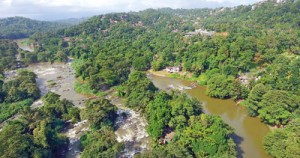
Waratenna-Hakkinda declared an EPA after long fought battle by environmentalists
The battle was long and hard, with victory being achieved this week, as Waratenna-Hakkinda in Kandy, home of a critically-endangered freshwater fish, being declared an Environmental Protection Area (EPA).
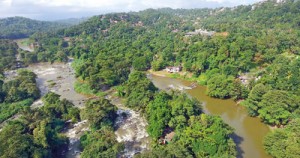
The spectacular Waratenna-Hakkinda area in Kandy
Environmentalists, foremost among whom is researcher Pradeep Samarawickrama are agog with excitement as President Maithripala Sirisena in his capacity as Environment Minister issued the Gazette Extraordinary 2024/06 dated June 19 and titled ‘Order to declare the Waratenna-Hakkinda EPA’ under Section 24C of the National Environmental Act.
Now Waratenna-Hakkinda joins Negombo’s Muthurajawela wetland; Nuwara Eliya’s Lake Gregory; Bulathsinhala’s Walawwewatta Waturana; Moratuwa’s Bolgoda Lake; Sri Jayewardenepura-Kotte’s Talangama Tank; Moneragala’s Maragala mountain range; Matale’s Knuckles mountain range; and Kandy’s Hantane mountain range as an EPA.
In these EPAs, the Central Environmental Authority ‘exercises, performs and discharges any powers, duties, functions related to planning and development’.
The Waratenna-Hakkinda EPA encompasses a one-kilometre stretch of the Mahaweli river which covers its narrowest point (three-metre width) and its widest point (1.7km-width), said environmental lawyer Jagath Gunawardene, explaining that the landmarks are, on one end the Getambe bridge and on the other, the Dodanwala suspension bridge.

Environmental lawyer Jagath Gunawardena
Referring to the importance of the area, he said that within the widest spot of the Mahaweli there are several rocky islands and there is a unique geological formation here.
“There is high biodiversity and high endemism with uniquely-adapted species, while the area is also of historical, cultural and religious value,” reiterated Mr. Gunawardena, ticking off the details on his fingers.
The area came under the spotlight when Mr. Samarawickrama in early 2011 found the critically-endangered gadeya or Green Labeo (Labeo fisheri) here and the Sunday Times launched a campaign seeking to protect Waratenna-Hakkinda.
The gadeya, a herbivorous fish, similar to the carp, is usually mud green or olive green and has a long, robust body with a mouth turned down. While it feeds on algae, it requires clear flowing water and a rocky bottom which aids the growth of algae.
Earlier it had been found in the Mahaweli system, at Polgolla and near Victoria, but with the construction of dams under the accelerated Mahaweli Scheme, its habitats had been submerged and changed.
Back in 1980, environmental scientist Dr. Ranil Senanayake had predicted that the Polgolla and Victoria projects would destroy the gadeya’s habitat while in 1990, Dr. Eric Wikramanayake had said that this fish may already be extinct.
The gadeya is the “most” significant faunal species inhabiting this area, said Mr. Gunawardena, listing some of the rare aquatic plants as six species of the endemic Podostemaceae, the endemic Cryptocoryne species threatened with extinction, the Lagenandra species and also a small community of yak-erabadu trees.
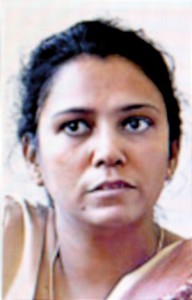
Prof. Deepthi Yakandawala
It was Prof. Deepthi Yakandawala of the Department of Botany, Faculty of Science, Peradeniya University who at that time pinpointed the dangers faced by the remarkable flowering plants of the family Podostemaceae and also the popular aquarium plants, the ‘water trumpet’ (Cryptocoryne, commonly known as Athi-udayan) due to the threats to this habitat.
She reiterated that six of the 10 species of the aquatic genus Cryptocoryne represented in Sri Lanka are critically endangered, while of the other four, three are endangered and one is vulnerable.
Waratenna-Hakkinda is also replete with birds, butterflies and dragonflies and is an area where a large number of fruit bats (flying foxes) roost, the Sunday Times learns, while the area is of high interest to geology as well as biology students.
“It is a study site,” says Mr. Gunawardena, pointing out that the aesthetic value of Waratenna-Hakkinda opens up the potential for eco-tourism.
However, he is emphatic that eco-tourism should not come in the form of putting up hotels, which is a clear “no, no” but more on the lines of walk-trails etc. There is breathtaking beauty around the Dodanwala suspension bridge.
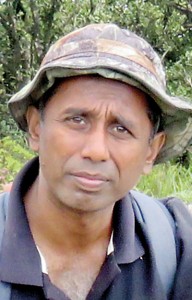
Researcher Pradeep Samarawickrama
The area was under severe threat from the hotel industry, housing, unauthorized filling and a mini-hydro power project which resulted in devastating dynamiting which killed the gadeya.
Environmentalists opened the eyes of the public as well as the authorities to the danger of such unplanned and unchecked development in the area.
The Sunday Times highlighted these issues in a series of articles starting with ‘Near-extinct fish faces death by dynamite’ on July 24, 2011; followed by ‘Now vital aquatic plants face similar fate as fish’ on August 7, 2011; and ‘CEA urged to protect endangered species area in Getambe’ on May 13, 2012.
Source – 25/06/2017, The Sunda Times, See more at – http://www.sundaytimes.lk/170625/news/waratenna-hakkinda-declared-an-epa-after-long-fought-battle-by-environmentalists-246593.html
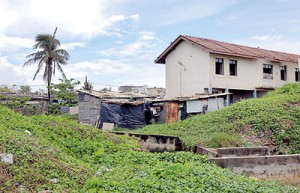
Tough new campaign to remove unauthorised structures on beaches
The Coast Conservation Department has launched a vigorous campaign to remove unauthorised constructions on beaches, Director General Prabath Chandrakeerthi told the Sunday Times.
He said so far more than 1,600 unauthorised structures had been issued notices, warning their occupants that if they failed to remove them, the Department would deploy its personnel to demolish them.
“We will have the support of the Special Task Force to provide security for the operations,” he said.
Mr. Chandrakeerthi said the campaign would target the beach stretch from Moratuwa to Mount Lavinia in the next two weeks and the next phase would cover the beach stretch from Mount Lavinia to Uswetakeiyawa in Wattala.
Under Sri Lanka’s Coast Conservation laws, the Department is empowered to remove unauthroised structures within 300 meters from the beach, the Director General said.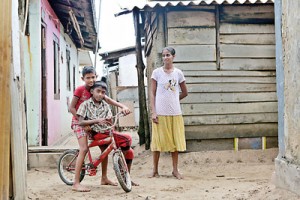
He said that among those unauthorised structures to be demolished are 49 temporary houses on the Mt Lavina and Moratuwa beaches. The residents are 2004 tsunami victims. Though they have been provided with alternative houses away from the beach, they have returned to their original places and put up temporary houses.
Mr. Chandrakeerthi said the Department would give the occupants two weeks to produce documents to prove the legality of the structures or temporary houses.
If the occupants produce the documents, their cases would be referred to the Defence Secretary under whose purview the Department comes. They are also entitled to make an appeal.
He said if the appeals are rejected, the occupants would have to remove the structures within two weeks. If they failed to do that, the department would demolish the structures and the occupants would have to pay the demolition cost.
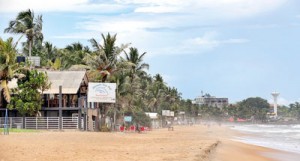
Unauthorised structures along the Dehiwela Mount Lavinia beach. Pix by Sameera Weerasekera

Source – 25/06/2017, The Sunday Times, See more at – http://www.sundaytimes.lk/170625/news/tough-new-campaign-to-remove-unauthorised-structures-on-beaches-246613.html



